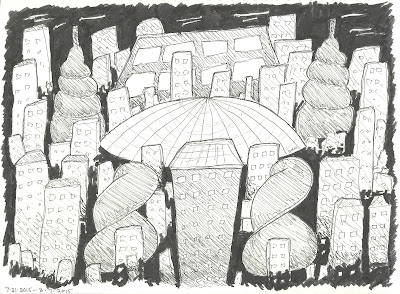Nowadays, it is rare to hear the word “pilgrimage.” Even more rare is when someone should invite you to participate in a pilgrimage. Somehow, though, when this very thing happened to me a few months ago, it didn’t come as a surprise to me. My time with Gioventù Studentesca hasn’t been long, but if there’s one thing I’ve learned it isn’t, it’s predictable.
It wasn’t until well after the pilgrimage that I realized what a senseless thing to do it would seem to someone not led by my motivations. To walk ten miles from one church to another, across an unfriendly landscape, carrying a statue on a litter on my shoulders, no less. Many would call this absurd.
This realization has caused me to question myself: Why should I want to go on a pilgrimage? Perhaps suffer discomfort and inconvenience? And most importantly, does this pilgrimage change anything in any substantial and meaningful way? I certainly was far from a fully realized person before this pilgrimage, so if it didn’t get me closer, was it worth it?
One reason to go on a pilgrimage is one that made itself present to me more than I expected, indeed, more than had ever even crossed my mind. We go on pilgrimage to bear witness to others. How strange it must be to see ordinary people walking along a trail where no one was meant to walk (seriously, I don’t remember crossing someone else’s path a single time). There was something definitely joyful about jarring people who seemed to have no business being jarred during their daily routine. But miraculously, people looked at us, people smiled, they honked their horns in approval. Some even asked "what on earth are you doing, and what’s that you’re carrying?" I almost wouldn’t know how to answer them, I’m just now figuring it out myself.
I, like many, have a very distracting life. And as most young people are, I’m exceedingly preoccupied with my future. I’m always trying to avoid the bad outcomes of life, and working to make the best one possible happen. But this whirlwind can make it hard to think about anything else. Now, I don’t think you should give up on your life plans, just consider why you have them.
While going on a ten-mile pilgrimage may seem like a pointless trip to nowhere, I think it was just what was needed. All my plans for what I want to be in the future mean nothing if I can’t find worth in what I am now. I was able to slow down and just walk, not for the sake of getting somewhere, but for the sake of being someone. And not just being someone, but encountering someone. I believe that God loves to meet us during events that are paradoxically both everyday, and bizarre. It’s His way of saying "Look! This could happen all the time, if you let it."
This pilgrimage opened up a new way of looking at the relationship between God and reality precisely because it took me somewhere I didn’t know I wanted to go. I saw with fresh eyes the nature of grace in the same way that a long absence from a familiar place brings back memories you forgot you had. It was a way of bringing my life back to the origin, finding a meaning to my plans that I couldn’t find while looking at them from the inside. Sometimes you just need that one crazy person to bring you outside of yourself. It’s better out there.
This article was originally written in response to the August 15th, 2014 Youngstown Marian Pilgrimage. All editing and formatting liberties are taken to reproduce this article.





